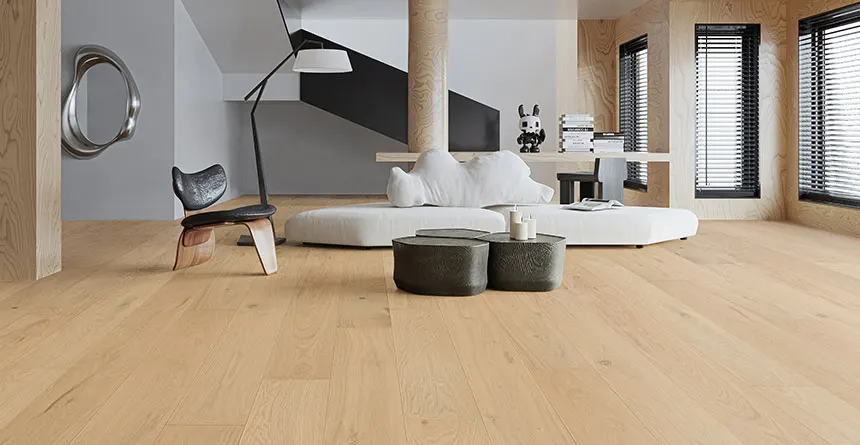There are two popular flooring options for homeowners who wish to beautify and enhance their homes and give their interiors more value: engineered timber flooring and European oak flooring. Each has its own unique qualities and attractions, both of which make them suitable for different but satisfying interior designs that achieve different effects. The article will present a full comparison of these two flooring alternatives, analysing their advantages in numerous areas to help homeowners, designers, and builders make educated selections.
Engineered Timber Flooring
Engineered timber flooring is resilient, versatile, and looks beautiful. It is made of several layers of wood that are glued together. The top layer, which is also called the wear layer, is actual wood; the lower layers are generally plywood or fibreboard. An engineered timber floor provides the added benefits of stability and resistance to moisture since it is used where ordinary hardwood flooring would be inappropriate—in basements and kitchens.
European Oak Flooring
Three top qualities make European oak flooring desirable: timeless elegance, endurance, and the innate characteristics of a premium wide board. Oak is a strong hardwood known for resisting every type of formidable force and providing an ideal option that will offer long-term protection against bad weather conditions such as heavy foot traffic. You can get European oak flooring in three different grades, including prime select or rustic, which allow homeowners to choose the level of character and variation in their floors. Also, you can choose from different cuts and finishes, allowing homeowners to satisfy their tastes as well as those of their unique homes.
Comparing the Benefits: Engineered Timber Flooring vs. European Oak Flooring
Due to the high quality of engineered timber flooring and European oak flooring, these two forms of flooring have been chosen by many homemakers. Although they have a few similarities, their benefits from each other are quite different.
1. Construction
- Engineered Timber Flooring: It is made of several layers of wood veneer with grain patterns running in different directions and glued together. This imparts stability to the structure, reducing the chances of warping or shrinkage that can occur with humidity changes.
- European Oak Flooring: This style of flooring is made from solid European oak wood and usually comes in planks. Essentially, it is just a traditional kind of type, but this material is durable and will not wear readily. The natural variations in grain pattern that can be seen in all hardwoods are shown to their full advantage.
2. Appearance
- Engineered Timber Flooring: With this type of flooring, the top layer, which is especially attractive for imitating different kinds of oak, may also be veneer.
- European Oak Flooring: Its natural grains and textures are well presented, all underscored by the genuine and bright colours of traditional oak wood.
3. Durability
- Engineered Timber Flooring: In terms of construction, engineered timber flooring is made up of several layers and, thus, compared to solid wood floors, is less affected by changes in moisture and temperature. But as to the materials used, different kinds of materials mean different kinds of durability.
- European Oak Flooring: Solid oak flooring is extremely durable. If properly maintained, it can last for many years without showing wear and can be refinished repeatedly to maintain its look.
4. Installation
- Engineered Timber Flooring: It is often much easier and quicker to put in than solid wood. Engineered boards may be installed either as floating floors or else nailed down or glued to the foundation.
- European Oak Flooring: Solid oak flooring often requires professional installation; typically, it must be nailed or glued onto the subfloor.
5. Cost
- Engineered Timber Flooring: Unlike solid oak flooring, engineered wood floors tend to be more wallet-friendly – both because of their construction and that they come in more price ranges.
- European Oak Flooring: Solid oak flooring is generally more expensive than engineered timber flooring because of its solid wood nature.
6. Environmental Considerations
- In choosing between engineered timber flooring and European oak flooring, one must carefully consider the effects on the environment. Engineered timber flooring will normally be more environmentally friendly than solid hardwood flooring. It uses less wood and generally contains various recycled materials in its composition. Choosing wooden products made by well-known manufacturers and observing ecological guidelines can have both a positive and negative impact on the natural environment.
- Moreover, putting European oak floors in one’s home from responsibly managed forests will require careful thought about the carbon footprint, especially if the wood comes from outside of your own country. To minimise environmental impact, choose European oak locally or choose certified sustainable products.
Conclusion
Both engineered timber and European oak flooring are excellent choices for homeowners and designers who want high-quality, durable, and beautiful floors. Engineered timber flooring offers greater stability and flexibility at a lower cost. It is European oak flooring, however, that radiates timeless elegance and strength, making it a timeless investment for any space. In any case, for those who understand these two types of floor coverings in terms of their differences, strengths, installation methods, and maintenance needs, as well as their environmental concerns, people will make choices that match their preferences and pocketbooks while keeping in mind the environment.




